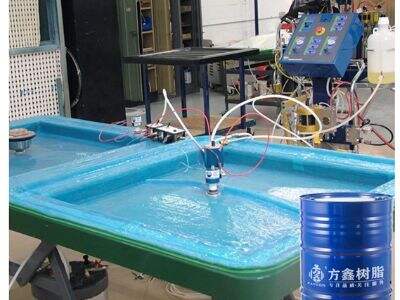इस लेख में, हम एक विशेष प्रक्रिया के बारे में चर्चा करेंगे जिसे RTM उत्पादन कहा जाता है। और यह हमें कई चीजों को उत्पादित करने की अनुमति देता है। क्या आपने इसे कभी सुना है? यह प्रक्रिया (RTM या रेजिन ट्रांसफर मोल्डिंग) कहते हैं। और यह प्लास्टिक और अन्य प्रकार की सामग्री ऑब्जेक्ट्स के निर्माण के लिए एक प्रक्रिया है। फ़ांगसिन ऐसी कंपनियों में से एक है जो इस रोचक प्रक्रिया का उपयोग करती है। वे RTM उत्पादन का उपयोग करके हमारे दैनिक जीवन में आने वाले विभिन्न प्रकार के उत्पादों को उत्पादित करते हैं।
RTM उत्पादन क्या है?
तो, RTM उत्पादन क्या है? मोल्ड एक ऐसा कंटेनर होता है जो हमारे निर्मित उत्पादों को आकार देता है। मोल्ड आमतौर पर दो हिस्सों से मिलकर बना होता है जो एक-दूसरे के साथ फिट होते हैं। रेजिन के इन्जेक्शन के दौरान, यह उन दो हिस्सों के बीच के खाली स्थान को अधिकृत कर लेता है। एक बार फ़ांगसिन के साथ इसे डालने पर आरटीएम रेजिन , फिर मोल्ड को गर्म कर दिया जाता है। ठंडा होने और ठीक होने पर, यह फिर खुलता है, और यह हमें भाग देता है। यह एक बहुत ही सुविधाजनक प्रक्रिया द्वारा किया जाता है, इसलिए अलग-अलग रूप और डिज़ाइन बनाना संभव होता है।
आपको RTM उत्पादन का उपयोग क्यों करना चाहिए?
इस प्रक्रिया से संबंधित कुछ उत्कृष्ट लाभ ये हैं कि इससे उत्पन्न होने वाले उत्पाद उच्च गुणवत्ता के होते हैं। यह हमें ऐसे भाग बनाने की अनुमति देता है जो बहुत विस्तृत और सौंदर्यमय होते हैं। उदाहरण के लिए, यदि हमें एक खिलौना या किसी प्रकार का फर्नीचर बनाना हो, उदाहरण के लिए सजावट, RTM उत्पादन हमें इसे बनाने की अनुमति देता है जिस तरह हम इसे देखना चाहते हैं।
RTM उत्पादन का दूसरा महत्वपूर्ण लाभ इसकी गति है। यह इसे कई उत्पाद तेजी से उत्पन्न करने की अनुमति देता है। हालांकि, ऐसे व्यवसायों के लिए जिन्हें तेजी से बहुत सारी चीजें उत्पन्न करने की आवश्यकता होती है, यह वह है जिसकी आवश्यकता होती है। एक खिलौना कंपनी की कल्पना करें जो छुट्टी के मौसम से पहले हजारों खिलौने उत्पन्न करना चाहती है। हालांकि, RTM उत्पादन इसे कुशलतापूर्वक संभव बनाता है।
RTM उत्पादन के लिए प्रक्रिया प्रवाह
अब, हम RTM निर्माण प्रक्रिया में शामिल महत्वपूर्ण चरणों की ओर गहराई से जाएं।
चरण 1: मोल्ड बनाएँ — यह चरण मोल्ड बनाने के लिए उद्देश्यित है। यह दो हिस्सों को एकसाथ मिलाकर एक बर्तन बनाने के द्वारा प्राप्त किया जाता है। फ़ांगसिन VARTM रेझिन को विशेष पदार्थों जिन्हें रिलीज़ एजेंट्स कहा जाता है, से ढके हुए मोल्ड पर लगाया जाता है, ताकि रेझिन न चिपक जाए।
चरण 1: रेझिन भरें – अगला चरण आपके मोल्ड में रेझिन का भरना है। इसका काम करने का कारण बल है; इस तरह, रेझिन को बल द्वारा भरा जाता है क्योंकि यह सुनिश्चित करता है कि मोल्ड में सभी छोटे-छोटे विवरण पूरी तरह से रेझिन से भर जाएँ। यदि अंतिम उत्पाद में रेझिन से सभी विवरण नहीं भरे, तो वह बदतरीके में दिखाई देगा।
रेझिन क्यूरिंग: एक बार रेझिन मोल्ड में जाता है, तो मोल्ड को घुमाकर एक ओवन में रख दिया जाता है। ओवन आकृति को गर्म करता है और रेझिन को ठोस होने में मदद करता है। यह क्यूरिंग कहलाती है। एक बार क्यूर होने के बाद, मोल्ड ओवन से बाहर निकलता है और खोला जाता है।
उत्पाद का निकालना — अंतिम कदम मोल्ड से अंतिम उत्पाद को बाहर निकालना है। यह कार्य मोल्ड के दो हिस्सों को ध्यान से अलग करके पूरा किया जाता है। हिस्सों को अलग करने पर, उत्पाद तुरंत उपयोग या विक्री के लिए उपलब्ध हो जाता है।
आरटीएम निर्माण अन्य विधियों की तुलना में
यह आरटीएम उत्पादन कुछ अन्य उत्पाद निर्माण विधियों की तुलना में थोड़ा अधिक है। आरटीएम उत्पादन अन्य मोल्ड विधियों की तुलना में कई फायदे हैं। इंजेक्शन मोल्डिंग — इंजेक्शन मोल्डिंग प्लास्टिक उत्पादों को बनाने के लिए एक अन्य ज्ञात तकनीक है। फिर भी, इंजेक्शन मोल्डिंग में कुछ हानिकारक बातें हैं। इसमें अपने अधिकतम आकार के निर्माण में सीमा है, साथ ही बहुत विस्तृत भागों को उत्पन्न करने में असमर्थ है।
दूसरी विधि कम्प्रेशन मोल्डिंग है। यह तकनीक उत्पाद के लिए सामग्री को एकसाथ दबाकर उपयोग करती है। हालांकि, कम्प्रेशन बहुत धीमी है और बहुत कम मात्रा में उत्पादन करती है। इसलिए, आम तौर पर, यह अधिकांश कंपनियों के लिए आरटीएम उत्पादन की तुलना में कहीं कम आर्थिक है।
संबंधित: आरटीएम (RTM) उत्पादन कैसे बेहतर उत्पादों और लागत की बचत को प्रोत्साहित करता है?
आरटीएम उत्पादों में अनेक विशेषताएँ होती हैं जिनसे उत्पादों को सुधारा जा सकता है। यह उन दैनिक वस्तुओं को बलवान बनाता है और उनका वजन कम रखता है, जो इतना आवश्यक है। इसके अलावा, यह बड़े और अधिक जटिल भागों को बनाने की क्षमता रखता है। यानी, आरटीएम उत्पादन ऐसे भागों को संभव बनाता है जो अन्य विधियों से बहुत कठिन या फिर संभव नहीं होते।
आरटीएम उत्पादन केवल उत्पादों को सुधारता है, बल्कि पैसे भी बचाता है। यह समय भी बचाता है क्योंकि यह एक तेज प्रक्रिया है जो अपनी प्रक्रिया में कई उत्पादों को बना सकती है। यह उत्पादित उत्पादों की कुल संख्या को बढ़ाता है और मजदूरी की लागत को कम करता है क्योंकि निश्चित मात्रा के उत्पाद को बनाने के लिए कम कर्मचारियों की आवश्यकता होती है। आरटीएम उत्पादन अपशिष्ट को कम करने में भी मदद कर सकता है। इसके अलावा, उत्पादन के बाद शेष रहने वाला रेझिन आमतौर पर अगले उत्पादन दफ़्तर में फिर से उपयोग किया जा सकता है, जिससे यह अधिक स्थिर हो जाता है।
आखिरी में, RTM उत्पादन एक प्रक्रिया है जो गुणवत्तापूर्ण उत्पादों को तेजी से बनाने की अनुमति देती है। फ़ांगसिन एक कंपनी है जो खुदरा व्यापार के लिए सामान्य उत्पादों को बनाने के लिए RTM का उपयोग करती है। फ़ांगसिन के बारे में अधिक जानकारी के लिए RTM वैक्यम इन्फ्यूज़न रेझिन उत्पादन, या इस अद्भुत प्रक्रिया में बनाए गए उत्पादों के उदाहरण देखने के लिए हमारी वेबसाइट पर जाएं। उम्मीद है कि आपको यह उपयोगी और दिलचस्प लगा होगा।
 EN
EN
 AR
AR
 BG
BG
 HR
HR
 CS
CS
 DA
DA
 NL
NL
 FI
FI
 FR
FR
 DE
DE
 EL
EL
 HI
HI
 IT
IT
 JA
JA
 KO
KO
 PL
PL
 PT
PT
 RO
RO
 RU
RU
 ES
ES
 SV
SV
 CA
CA
 TL
TL
 ID
ID
 LV
LV
 SR
SR
 VI
VI
 GL
GL
 TH
TH
 TR
TR
 AF
AF
 MS
MS
 GA
GA
 AZ
AZ
 BN
BN
 LA
LA
 MN
MN
 NE
NE
 KK
KK
 UZ
UZ






